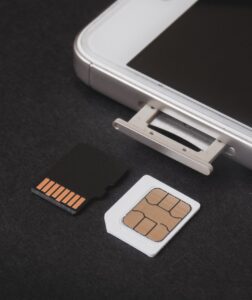Introduction
The fifth generation of mobile network technology, commonly referred to as 5G, has garnered immense attention and anticipation due to its potential to revolutionize connectivity. It represents a significant leap forward from its predecessors, including 4G (LTE) and 3G. In this article, we will delve into the key differences that set 5G apart from previous generations of mobile networks, exploring the technical advancements, use cases, and implications for various industries and everyday life.

-
Understanding the Generations of Mobile Networks
To appreciate the differences introduced by 5G, it’s essential to understand the evolution of mobile networks. Mobile telecommunications have progressed through several generations, each marked by significant advancements:

1.1 1G: First Generation
The first-generation (1G) networks, introduced in the early 1980s, were analog systems primarily focused on voice calls. They provided basic voice communication capabilities but lacked digital data services.

1.2 2G: Second Generation
The second-generation (2G) networks, which emerged in the 1990s, introduced digital technology and provided data services for text messaging (SMS) and limited data transfer. The most notable 2G standard was GSM (Global System for Mobile Communications).
1.3 3G: Third Generation
The third-generation (3G) networks, deployed in the early 2000s, brought improved data capabilities, enabling internet access, email, and multimedia services. Key 3G technologies included UMTS (Universal Mobile Telecommunications System) and CDMA2000.
1.4 4G: Fourth Generation (LTE)
The fourth-generation (4G) networks, rolled out in the late 2000s, offered substantial improvements in data speed, capacity, and latency reduction. Long-Term Evolution (LTE) technology became the global standard for 4G networks, facilitating high-speed internet access and mobile applications.

Now, let’s explore how 5G technology differs from these previous generations.
-
Key Differences Between 5G and Previous Mobile Networks
5G technology represents a significant departure from its predecessors in several key aspects:
2.1 Data Speed and Capacity
One of the most notable differences is the dramatic increase in data speed and capacity:
- 4G: 4G networks typically provide download speeds of up to 100 Mbps (megabits per second) and upload speeds of up to 50 Mbps. While this allows for smooth video streaming and web browsing, it may not be sufficient for emerging applications.
- 5G: 5G networks promise blazing-fast speeds, with peak download rates reaching up to 20 Gbps (gigabits per second). This enables real-time 4K video streaming, low-latency gaming, and rapid file downloads. Additionally, 5G supports significantly higher device densities, allowing for more simultaneous connections in crowded areas.

2.2 Latency
Latency, or the delay between sending a request and receiving a response, is a critical metric for many applications:
- 4G: 4G networks typically have latency in the range of 30 to 50 milliseconds (ms). While this is suitable for most applications, it may introduce noticeable delays in time-sensitive use cases, such as online gaming or autonomous vehicles.
- 5G: 5G networks are designed to deliver ultra-low latency, often below 1 ms. This near-instantaneous response time is crucial for applications like augmented reality (AR), virtual reality (VR), telemedicine, and autonomous vehicles, where split-second decisions are essential.
2.3 Frequency Bands
5G utilizes a wider range of frequency bands, including both lower and higher frequencies:
- 4G: 4G primarily operates in the sub-6 GHz frequency range. While this provides good coverage and penetration through buildings, it may become congested in densely populated areas.
- 5G: 5G leverages a broader spectrum, including the sub-6 GHz (for wide coverage) and mmWave (millimeter-wave) frequencies. mmWave, in particular, offers exceptionally high bandwidth but has shorter propagation distances and is more sensitive to obstacles. This mix of frequencies enables 5G to provide both broad coverage and ultra-fast speeds.

2.4 Network Architecture
5G introduces a more flexible and dynamic network architecture:
- 4G: 4G networks have a relatively static architecture with centralized core networks. This limits their ability to adapt to changing traffic patterns and requirements.
- 5G: 5G employs a more dynamic, software-defined network (SDN) architecture, with a distributed core and edge computing capabilities. This allows for network slicing, where multiple virtual networks can coexist on the same physical infrastructure, each tailored to specific applications, such as IoT, critical communications, or entertainment.
2.5 Massive Internet of Things (IoT) Support
While 4G networks can support IoT applications to some extent, 5G is designed to be the ideal platform for IoT:
- 4G: 4G networks can accommodate a moderate number of IoT devices, but they may struggle to handle the massive scale of IoT deployments expected in the future.
- 5G: 5G networks offer robust support for IoT with features like Narrowband IoT (NB-IoT) and Cat-M1, designed for low-power, wide-area IoT devices. They can connect millions of devices per square kilometer, making 5G ideal for applications like smart cities, industrial automation, and connected vehicles.

2.6 Network Slicing and Quality of Service (QoS)
5G introduces the concept of network slicing, enabling the creation of virtual networks with specific quality-of-service parameters:
- 4G: 4G networks provide a best-effort service, where all traffic is treated equally. This limits their suitability for applications that require guaranteed performance levels.
- 5G: 5G enables network operators to create dedicated slices with predefined QoS characteristics. This means that critical services like emergency communications can be prioritized over less time-sensitive applications, ensuring a more reliable and predictable user experience.
2.7 Edge Computing
5G networks leverage edge computing to process data closer to the source, reducing latency and enabling real-time processing:
- 4G: 4G networks rely on centralized data centers, leading to higher latency for applications that require rapid data processing.
- 5G: 5G integrates edge computing into the network architecture, allowing data processing to occur at the network’s edge. This is crucial for applications like autonomous vehicles, where split-second decisions are required, and data cannot afford to travel long distances for processing.

III. Use Cases and Applications of 5G Technology
The unique characteristics of 5G technology open the door to a wide range of applications across various industries:
3.1 Enhanced Mobile Broadband (eMBB)
5G offers significantly faster download and upload speeds, enabling more immersive experiences:
- Streaming: 5G enables seamless 4K and even 8K video streaming on mobile devices, reducing buffering and enhancing video quality.
- Gaming: Low-latency 5G connections enhance the gaming experience, enabling cloud gaming services and multiplayer gaming without noticeable lag.
- Augmented and Virtual Reality: 5G enables more realistic and responsive AR and VR experiences, from gaming to industrial training and healthcare applications.
3.2 Internet of Things (IoT)
5G’s support for massive IoT deployments makes it ideal for various IoT applications:
- Smart Cities: 5G enables efficient management of traffic lights, waste collection, and public transportation systems. It also supports smart street lighting and environmental monitoring.
- Industrial IoT (IIoT): In manufacturing, 5G facilitates real-time monitoring and control of machines and robots, improving automation and efficiency.
- Agriculture: Farmers can use 5G-connected sensors and drones for precision agriculture, optimizing crop yields and resource usage.

3.3 Autonomous Vehicles
5G plays a critical role in enabling vehicle-to-everything (V2X) communication for autonomous vehicles:
- Safety: 5G enables vehicles to communicate with each other and with infrastructure (V2V and V2I), enhancing safety by preventing accidents through real-time data exchange.
- Traffic Optimization: Autonomous vehicles can access up-to-the-minute traffic data and optimize routes for fuel efficiency and reduced congestion.
- Remote Control: 5G allows for remote control of vehicles in hazardous environments, such as mining or firefighting.
3.4 Healthcare
5G’s low latency and reliability are game-changers in the healthcare industry:
- Telemedicine: Doctors can perform remote surgeries and consultations with minimal latency, making telemedicine more accessible and effective.
- Remote Patient Monitoring: Wearable devices connected to 5G networks can continuously monitor patients’ vital signs and send data to healthcare providers in real time.
- Healthcare IoT: IoT devices, such as smart prosthetics and connected medical equipment, benefit from 5G’s reliability and low latency.

3.5 Smart Cities
5G is the backbone of smart city initiatives, transforming urban infrastructure:
- Traffic Management: 5G-powered traffic management systems optimize traffic flow, reduce congestion, and improve transportation efficiency.
- Public Safety: First responders can benefit from real-time data and video streaming for faster incident response and coordination.
- Energy Efficiency: 5G networks enable smart grid technologies, reducing energy waste and enhancing sustainability.
3.6 Industrial Automation
Manufacturing and industrial sectors benefit from 5G’s reliability and low latency:
- Robotics: 5G enables real-time communication between robots, machines, and control systems, enhancing automation and efficiency.
- Quality Control: Manufacturers can implement real-time quality control systems that detect defects and anomalies instantly.
- Supply Chain Optimization: 5G helps optimize supply chain operations by tracking goods and shipments in real time.
- Challenges and Considerations with 5G
Despite its potential, 5G technology comes with its own set of challenges and considerations:
4.1 Infrastructure Deployment
Deploying a 5G infrastructure requires significant investments in new equipment, towers, and fiber-optic networks. The rollout of 5G networks in rural or remote areas can be particularly challenging due to cost constraints.

4.2 Spectrum Allocation
Effective spectrum allocation is crucial for 5G’s success. Governments and regulatory bodies must allocate sufficient spectrum for 5G services while ensuring interference management and fair access.
4.3 Security and Privacy
5G networks introduce new security challenges, such as increased attack surfaces and potential vulnerabilities. Robust security measures are essential to protect against cyber threats and ensure user privacy.
4.4 Interoperability
As 5G networks evolve, ensuring interoperability between different network equipment vendors and service providers is crucial to avoid fragmentation and enable seamless connectivity.
4.5 Spectrum Congestion
In densely populated areas, spectrum congestion can occur due to the high number of connected devices. Effective spectrum management and dynamic allocation are needed to address this issue.
-
Conclusion
5G technology represents a significant leap forward in mobile network evolution, offering unprecedented speed, low latency, and connectivity for a wide range of applications. Its impact extends beyond personal mobile devices, reaching industries like healthcare, transportation, manufacturing, and smart cities. However, addressing the challenges of infrastructure deployment, security, and spectrum management is essential to fully realize 5G’s potential.
As 5G networks continue to expand and mature, they have the potential to transform how we live, work, and interact with the world around us. Whether it’s enabling remote surgeries, powering autonomous vehicles, or optimizing supply chains, 5G is poised to play a central role in shaping the future of connectivity and technology.

